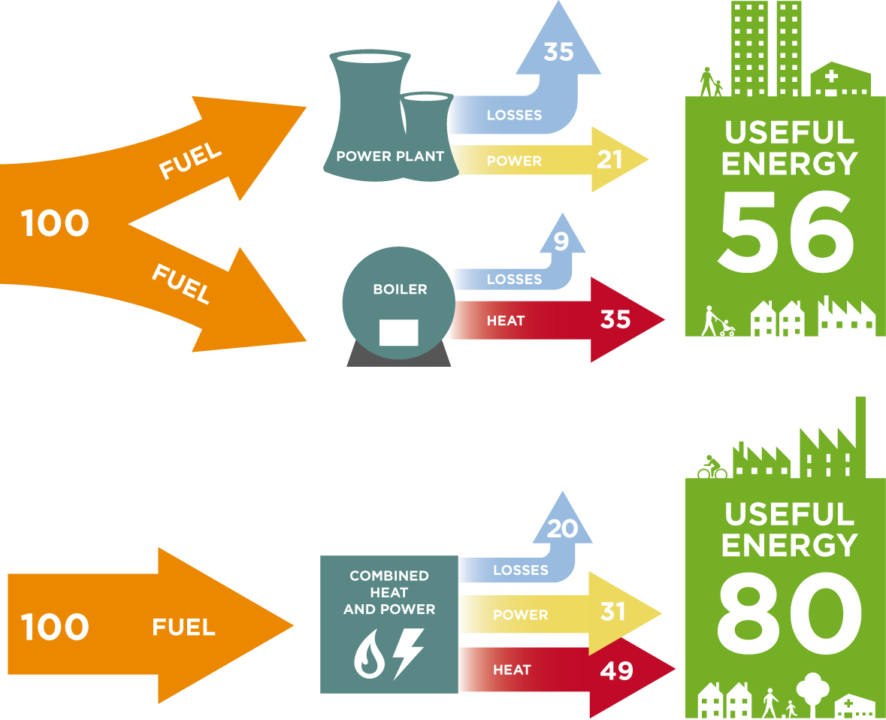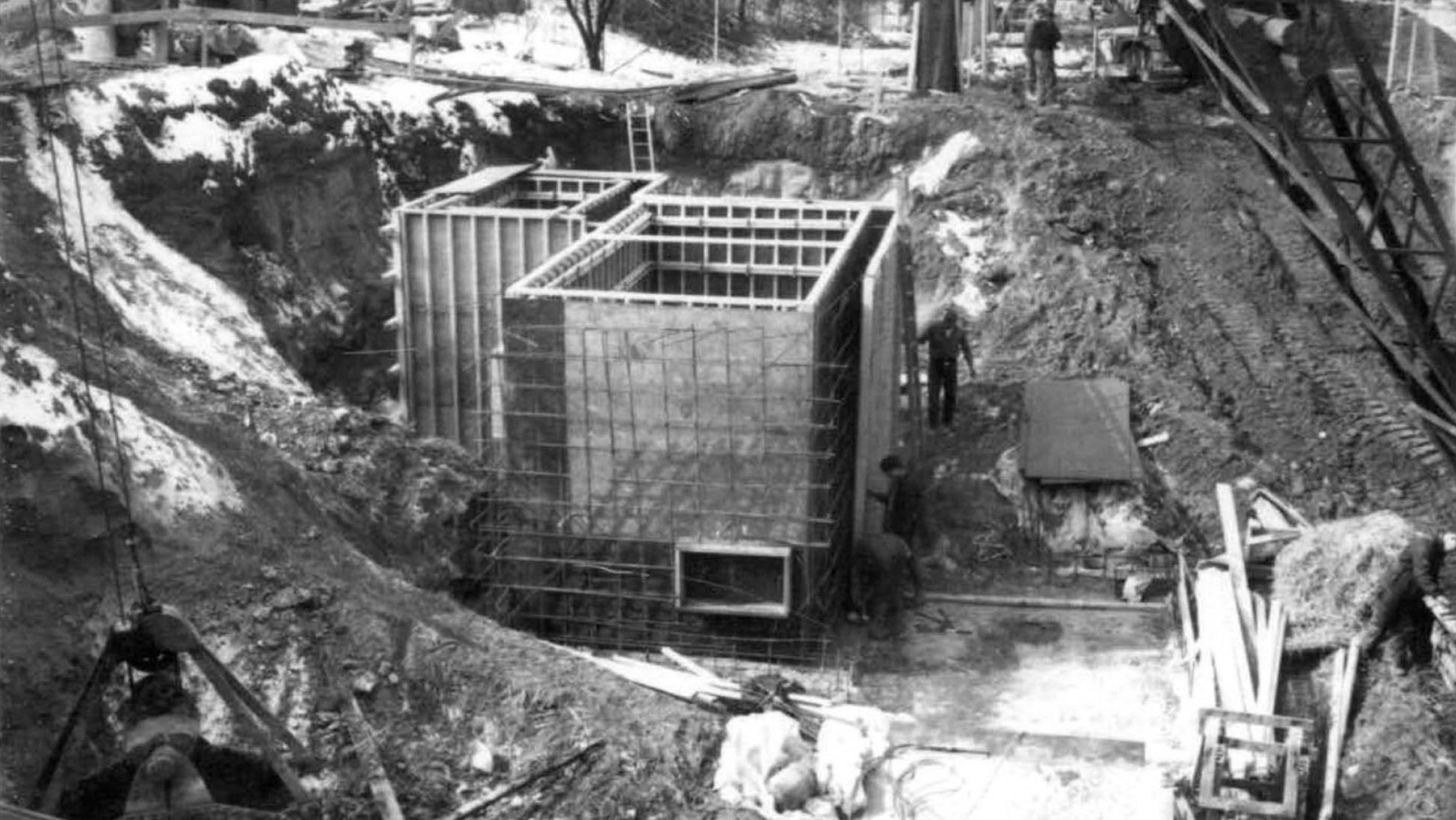On cold winter days, clouds of steam can be seen drifting from the Central Utilities Cogen Plant (Cogen), located between the River Campus and the Medical Center Campus. But what is Cogen? And why has the University chosen this more efficient option to power its buildings? The evolution from the initial coal-fired central heating plant built in 1903 to the current Cogen system tells a story of how the University has consistently advanced its power systems to be more environmentally and economically efficient. This can be seen as one of the most significant efforts along the University’s path in sustainability.
University President Rush Rhees was a pioneer believing in the vision of centralized heating and electrical generation. He first built a coal-fired central steam heating plant on the original campus east of downtown Rochester. In the mid-1920s, a second coal-fired system was installed in what is currently the Central Utilities Plant. Rhees was first to light the fires in the original boilers. Upgrades made at this location paralleled technological advancements, as the system’s energy source changed from coal to natural gas and distillate fuel oil. Currently, the system is transitioning from steam and hot water delivery.

The current cogeneration system, known as Cogen, is a notable milestone for the University as it is able to simultaneously generate both electricity and usable heat. More specifically, the plant’s current cogeneration system produces electricity from steam while reclaiming the excess thermal energy from the process to heat many of the campus buildings. What began strictly as a heating system has evolved to produce a significant portion of the campus’s electrical requirements and is optimized to meet the needs of the University as it continues to grow.
Below is a brief timeline that outlines the steps taken by the University to evolve from a coal fired plant to the current Cogen plant:
- 1903: A coal-fired central steam heating plant on the original downtown campus was built.
- Mid-1920s: A heating plant was built south of the city for the new School of Medicine and the land along the Genesee River–today known as the River Campus. Underground tunnels helped distribute steam to buildings on both campuses.
- 1924: A second steam plant was added as the University continued to grow.
- 1930s: The idea of adding cogeneration to the central plant was first proposed and studied. (1977 History of the University of Rochester, by Arthur J. May)
- 1967: The first steam driven chillers were added to the Central Utilities Plant and the Central Plant began to produce chilled water to cool buildings for the first time.
- 1970s: A second boiler plant was expanded and a chiller plant was built.
- 1998: Four out of five boilers were converted to burn natural gas and distillate fuel oil.
- 2003: Research was conducted on Combined Heat and Power (CHP), an energy efficient technology that generates electricity and utilizes the heat that would otherwise be wasted. The heat is used to provide thermal energy to warm buildings.
- 2004: Installation of the new hot water district heating system began.
- Late 2005: The new hot water system was completed along with the cogeneration system.
- 2007: The Mid-Campus Chiller Plant was constructed as a satellite to the Central Utilities plant to provide additional chilled water to the Medical Center and River Campus using electrical chillers, which were significantly more efficient than the steam driven chillers.
- 2012: The Mid-Campus Chiller Plant was expanded with additional high efficient electric driven chillers.
- Present: The University is gradually transitioning most of its buildings from steam heating to Cogen produced hot water. Currently about 50% of the load has been shifted to Cogen hot water.
Archived photos of the heating system construction can be found here. The photo above, taken March 9, 1967, is an electrical vault being constructed near the current central plant.
So why is the Cogen plant a much more efficient option? Cogeneration, also known as Combined Heat and Power (CHP), is the process of generating electricity with a heat source (in this case steam) and recovering the unutilized heat from the electrical generation (in this case hot water) and converting that into usable energy to heat buildings. Electrical generation is inherently inefficient. A typical industrial turbine generator converts about 1/3 of the energy from the fuel source into electricity and the remaining 2/3 of the source energy is rejected to the atmosphere. A cogeneration system captures most of the rejected energy and does something useful with it. This can dramatically increase the overall (combined) efficiency of the process, typically in the 60-80% range.

Image source http://blogs.nottingham.ac.uk/sustainablenottingham/2016/09/29/12982/chp-diagram/
Cogeneration has many benefits including:
- Increased overall plant energy efficiency.
- Reduces environmental impact, such as CO2 and NOX emissions.
- Reduces power purchased from external utility which lowers cost to the University.
- The natural gas used to produce the steam burns much cleaner and produces much less greenhouse gas emissions and pollutants than burning of coal.
- Increases resiliency by reducing dependence on the electrical utility.
- Provides more control over electrical peak demand from utility, further reducing the cost of purchased power.
The Cogen system currently generates about 1/3 of the electricity and about 1/2 of the thermal heating used by the River Campus and Medical Center. As we transition more buildings from steam heating to hot water heating those numbers will continue to increase.
Special thanks to energy manager and adjunct assistant professor of history Morris Pierce and John M & Barbara Keil University Archivist Melissa Mead for providing information and imagery.
Written by Emily Su, Class of 2022


Dorothy that is truly incredible! How neat that your father was a part of the power plant’s history here! 🙂
I think that the man in picture #3 is my father. He was a stationary engineer for for over 25 years. I can remember when the UR had the coal cars.